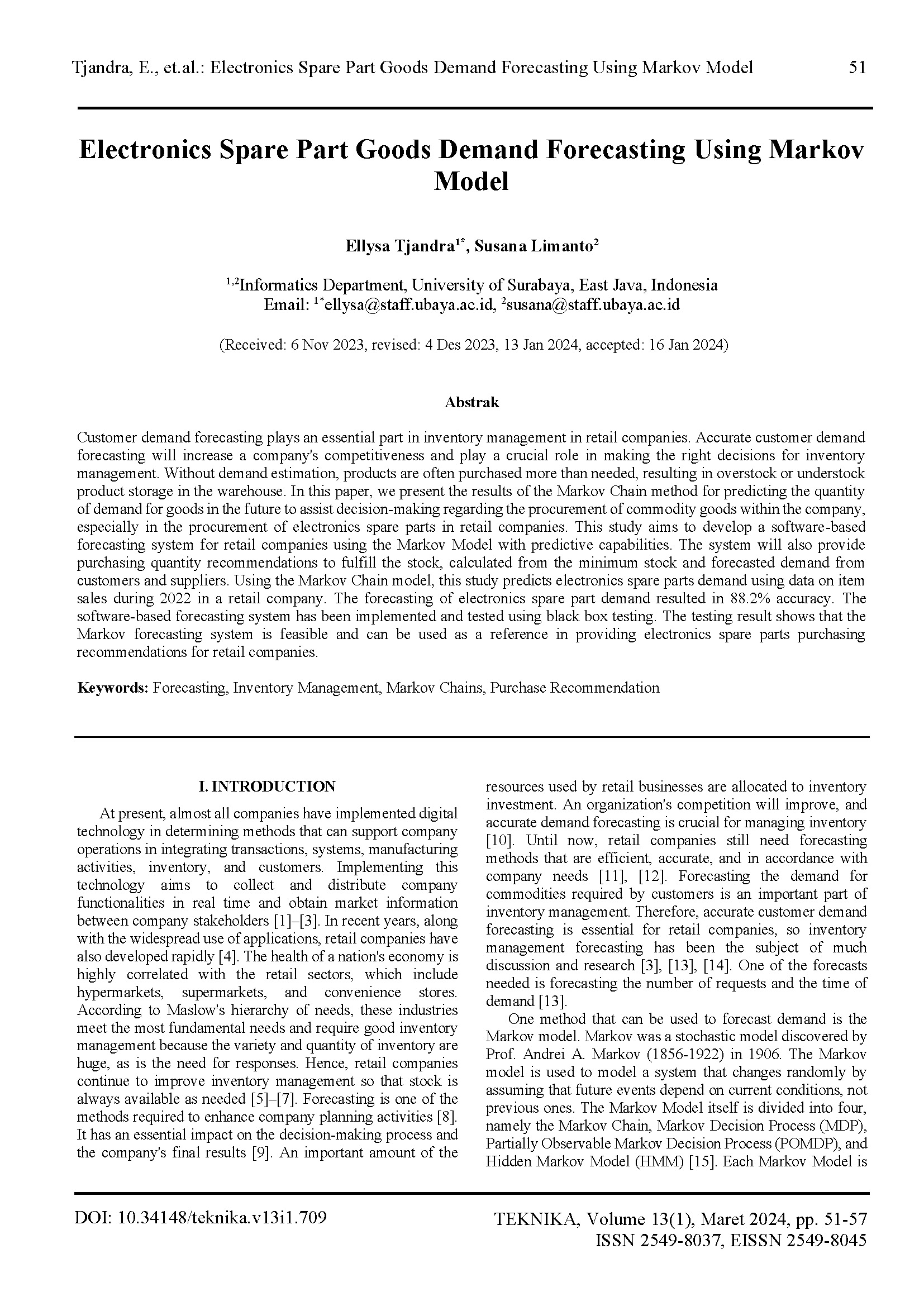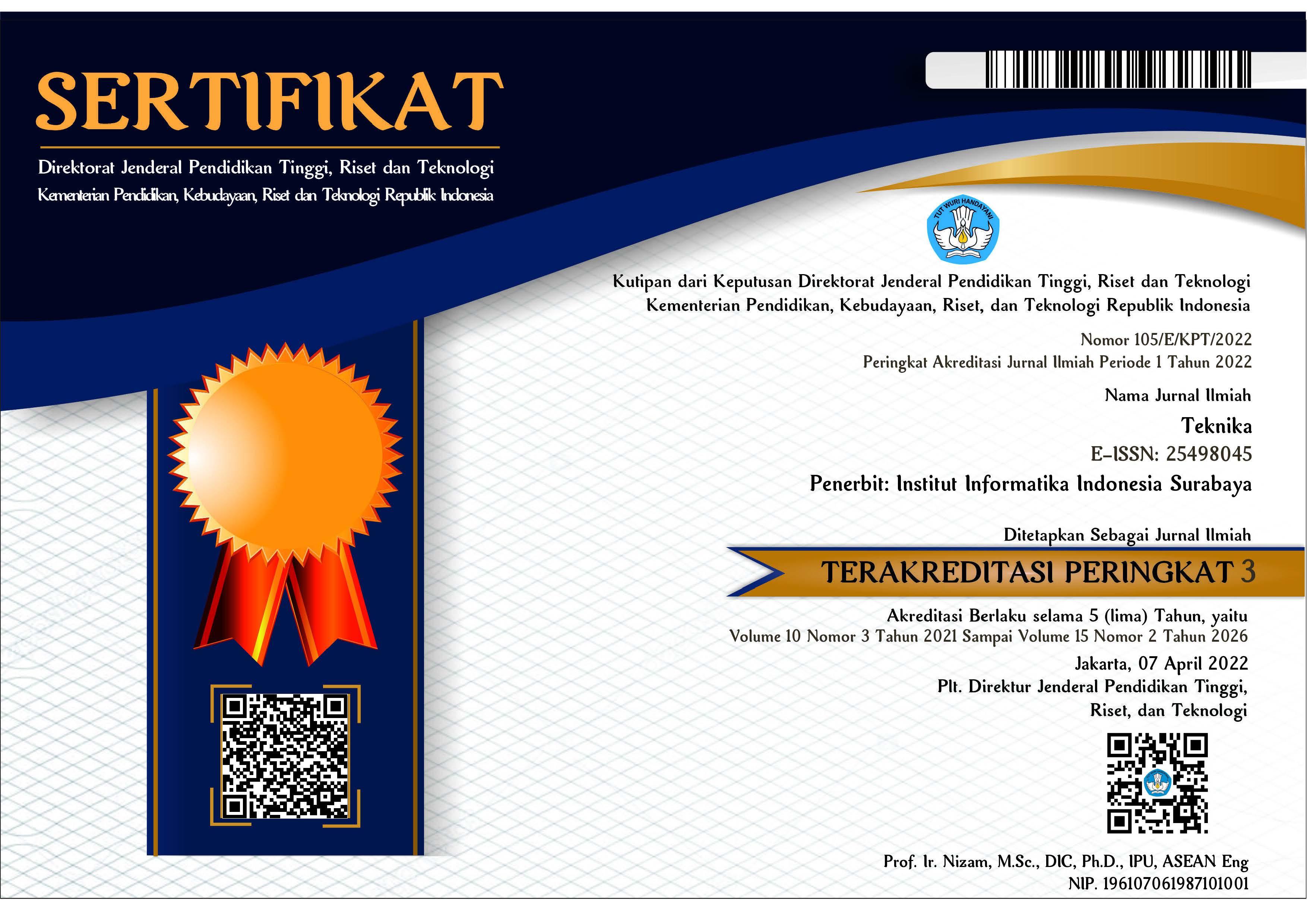Electronics Spare Part Goods Demand Forecasting Using Markov Model
DOI:
https://doi.org/10.34148/teknika.v13i1.709Keywords:
Forecasting, Inventory Management, Markov Chains, Purchase RecommendationAbstract
Customer demand forecasting plays an essential part in inventory management in retail companies. Accurate customer demand forecasting will increase a company's competitiveness and play a crucial role in making the right decisions for inventory management. Without demand estimation, products are often purchased more than needed, resulting in overstock or understock product storage in the warehouse. In this paper, we present the results of the Markov Chain method for predicting the quantity of demand for goods in the future to assist decision-making regarding the procurement of commodity goods within the company, especially in the procurement of electronics spare parts in retail companies. This study aims to develop a software-based forecasting system for retail companies using the Markov Model with predictive capabilities. The system will also provide purchasing quantity recommendations to fulfill the stock, calculated from the minimum stock and forecasted demand from customers and suppliers. Using the Markov Chain model, this study predicts electronics spare parts demand using data on item sales during 2022 in a retail company. The forecasting of electronics spare part demand resulted in 88.2% accuracy. The software-based forecasting system has been implemented and tested using black box testing. The testing result shows that the Markov forecasting system is feasible and can be used as a reference in providing electronics spare parts purchasing recommendations for retail companies.
Downloads
References
L. Ardito, A. M. Petruzzelli, U. Panniello, and A. C. Garavelli, “Towards Industry 4.0: Mapping digital technologies for supply chain management-marketing integration,” Bus. Process Manag. J., vol. 25, no. 2, pp. 323—346, 2019, doi: 10.1108/BPMJ-04-2017-0088.
R. Fildes, S. Ma, and S. Kolassa, “Retail forecasting: Research and practice,” Int. J. Forecast., vol. 38, no. 4, pp. 1283—1318, 2022, doi: 10.1016/j.ijforecast.2019.06.004.
T. Falatouri, F. Darbanian, P. Brandtner, and C. Udokwu, “Predictive Analytics for Demand Forecasting - A Comparison of SARIMA and LSTM in Retail SCM,” Procedia Comput. Sci., vol. 200, no. 2019, pp. 993—1003, 2022, doi: 10.1016/j.procs.2022.01.298.
X. Li, X. Zhao, W. (Ato) Xu, and W. Pu, “Measuring ease of use of mobile applications in e-commerce retailing from the perspective of consumer online shopping behaviour patterns,” J. Retail. Consum. Serv., vol. 55, no. January, p. 102093, 2020, doi: 10.1016/j.jretconser.2020.102093.
A. Hübner and H. Kuhn, Decision support for managing assortments, shelf space, and replenishment in retail, no. 0123456789. Springer US, 2023.
C. Kouki, M. Z. Babai, Z. Jemai, and S. Minner, “Solution procedures for lost sales base-stock inventory systems with compound Poisson demand,” Int. J. Prod. Econ., vol. 209, pp. 172—182, 2019, doi: 10.1016/j.ijpe.2018.01.021.
C. H. Wang, “Considering economic indicators and dynamic channel interactions to conduct sales forecasting for retail sectors,” Comput. Ind. Eng., vol. 165, no. September 2021, p. 107965, 2022, doi: 10.1016/j.cie.2022.107965.
F. Petropoulos et al., “Forecasting: theory and practice,” Int. J. Forecast., vol. 38, no. 3, pp. 705—871, 2022, doi: 10.1016/j.ijforecast.2021.11.001.
A. Westerski, R. Kanagasabai, J. Wong, and H. Chang, “Prediction of enterprise purchases using Markov models in procurement analytics applications,” Procedia Comput. Sci., vol. 60, no. 1, pp. 1357—1366, 2015, doi: 10.1016/j.procs.2015.08.209.
R. Lackes, M. Siepermann, and G. Vetter, “What drives decision makers to follow or ignore forecasting tools - A game based analysis,” J. Bus. Res., vol. 106, no. February 2019, pp. 315—322, 2020, doi: 10.1016/j.jbusres.2019.02.036.
X. Tian, H. Wang, and E. E, “Forecasting intermittent demand for inventory management by retailers: A new approach,” J. Retail. Consum. Serv., vol. 62, no. July, p. 102662, 2021, doi: 10.1016/j.jretconser.2021.102662.
R. Fildes and P. Goodwin, “Stability in the inefficient use of forecasting systems: A case study in a supply chain company,” Int. J. Forecast., vol. 37, no. 2, pp. 1031—1046, 2021, doi: 10.1016/j.ijforecast.2020.11.004.
K. Nikolopoulos, “We need to talk about intermittent demand forecasting,” Eur. J. Oper. Res., vol. 291, no. 2, pp. 549—559, 2021, doi: 10.1016/j.ejor.2019.12.046.
A. Roozbeh Nia, A. Awasthi, and N. Bhuiyan, “Industry 4.0 and demand forecasting of the energy supply chain: A literature review,” Comput. Ind. Eng., vol. 154, no. January, p. 107128, 2021, doi: 10.1016/j.cie.2021.107128.
S. Guo, L. Si, and X. Liu, “applied sciences Research Practice and Progress of Models and Algorithms Applied in Topic Identification and Prediction Based on the Analysis of CNKI,” 2023.
R. Rajesh, A. K. Agariya, and C. Rajendran, “Predicting resilience in retailing using grey theory and moving probability based Markov models,” J. Retail. Consum. Serv., vol. 62, no. November 2020, p. 102599, 2021, doi: 10.1016/j.jretconser.2021.102599.
F. Lolli, R. Gamberini, A. Regattieri, E. Balugani, T. Gatos, and S. Gucci, “Single-hidden layer neural networks for forecasting intermittent demand,” Int. J. Prod. Econ., vol. 183, no. July 2016, pp. 116—128, 2017, doi: 10.1016/j.ijpe.2016.10.021.
M. Baisariyev et al., “Demand forecasting methods for spare parts logistics for aviation: A real-world implementation of the Bootstrap method,” Procedia Manuf., vol. 55, no. C, pp. 500—506, 2021, doi: 10.1016/j.promfg.2021.10.068.
S. Poormoaied and E. Z. Demirci, Analysis of an inventory system with emergency ordering option at the time of supply disruption, vol. 43, no. 4. Springer Berlin Heidelberg, 2021.
I. Maulidi, C. Hayati, and V. Apriliani, “Optimal Raw Material Inventory Analysis Using Markov Decision Process with Policy Iteration Method,” vol. 6, no. 3, pp. 638—650, 2022, [Online]. Available: http://journal.ummat.ac.id/index.php/jtam.
Yudistira Adi Nugraha, “Pembuatan Sistem Peramalan Permintaan Barang pada Toko Elektronik dengan Markov Model,” Final Proj., 2018.























